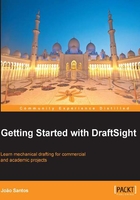
What this book covers
Chapter 1, Introduction to DraftSight, includes an introduction to DraftSight, where to download it, how to start and configure it, creating and configuring a drawing, and all the commands to open, save and close drawings.
Chapter 2, Drawing with Precision, includes all the important tools that allow drawing with precision, namely coordinates and graphical auxiliary tools, how to draw lines and erase entities, and also the most important visualization commands.
Chapter 3, Starting to Create Projects, includes the most important commands to start creating projects, including different types of entities creation such as circles, arcs, rectangles, and polygons. This chapter also covers modification, such as moving, rotating, scaling, copying, mirroring, creating parallel entities, and moving vertices.
Chapter 4, Structuring Projects and Following Standards, includes the main entity properties essential to a correct structure of any drawing, layer being the most important. Three other important properties normally controlled by layer are color, linestyles, and lineweights.
Chapter 5, Inquiring Projects and Modifying Properties, includes several commands for obtaining information in the drawing, two commands to modify entities properties, and a command to select entities based on properties values.
Chapter 6, Creating Complex Projects, includes several commands that allow specific functions important to create complex projects, such as text and text styles, polylines, equally spaced copies, ellipses, rings, revision clouds, tables and table styles, joining and splitting entities.
Chapter 7, Creating and Applying Components, includes commands related to the creation, insertion and other operations about components (blocks). A component, or block, is a set of entities belonging to one or more layers that are grouped together and that can be used as a single element.
Chapter 8, Applying Fills and Patterns, presents hatches, which represent sections, cuts, or materials. Hatches can be a regular pattern composed by families of lines, a single color, or a gradient between two colors.
Chapter 9, Documenting Projects, includes the commands used to document or dimension a drawing, such as linear dimensions, angular dimensions, radius and diameters, ordinate and leader dimensions. Also included are the commands to edit dimensions and dimension styles.
Chapter 10, Printing Efficiently, includes the preparation of sheets for printing, previewing and printing drawings. The concept of sheet, and it's advantages, is introduced.
Chapter 11, Advanced Tools, introduces some advanced concepts and commands, namely referencing other drawings and images, and additional layer commands, very useful when dealing with complex drawings.